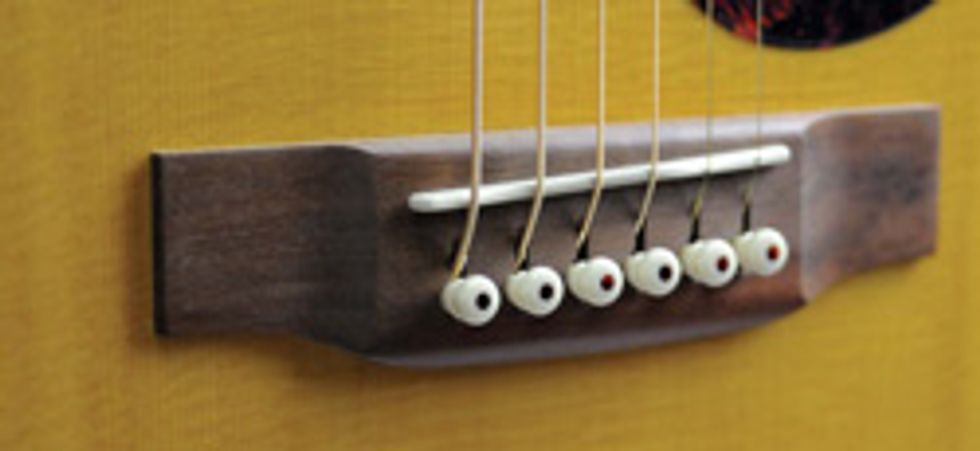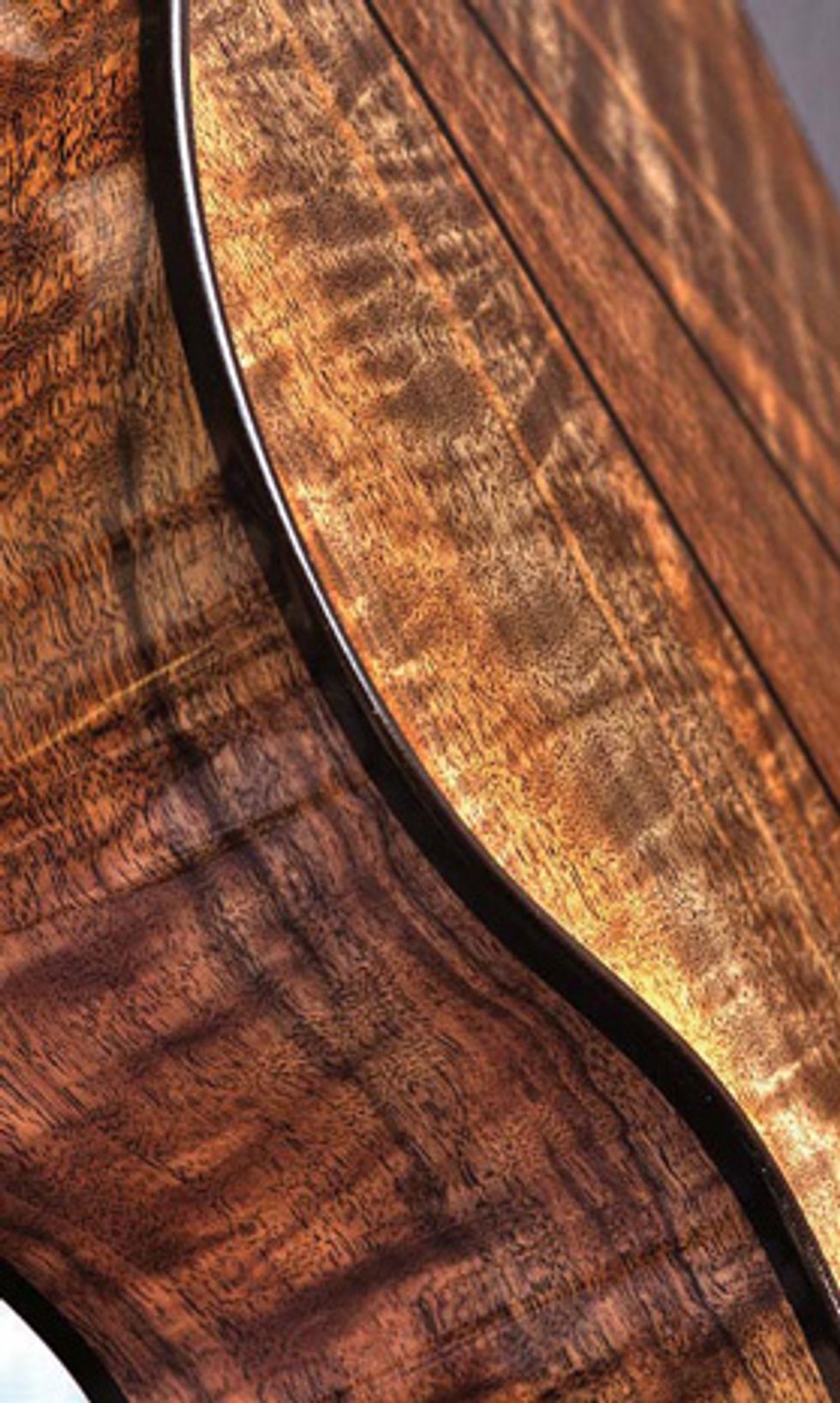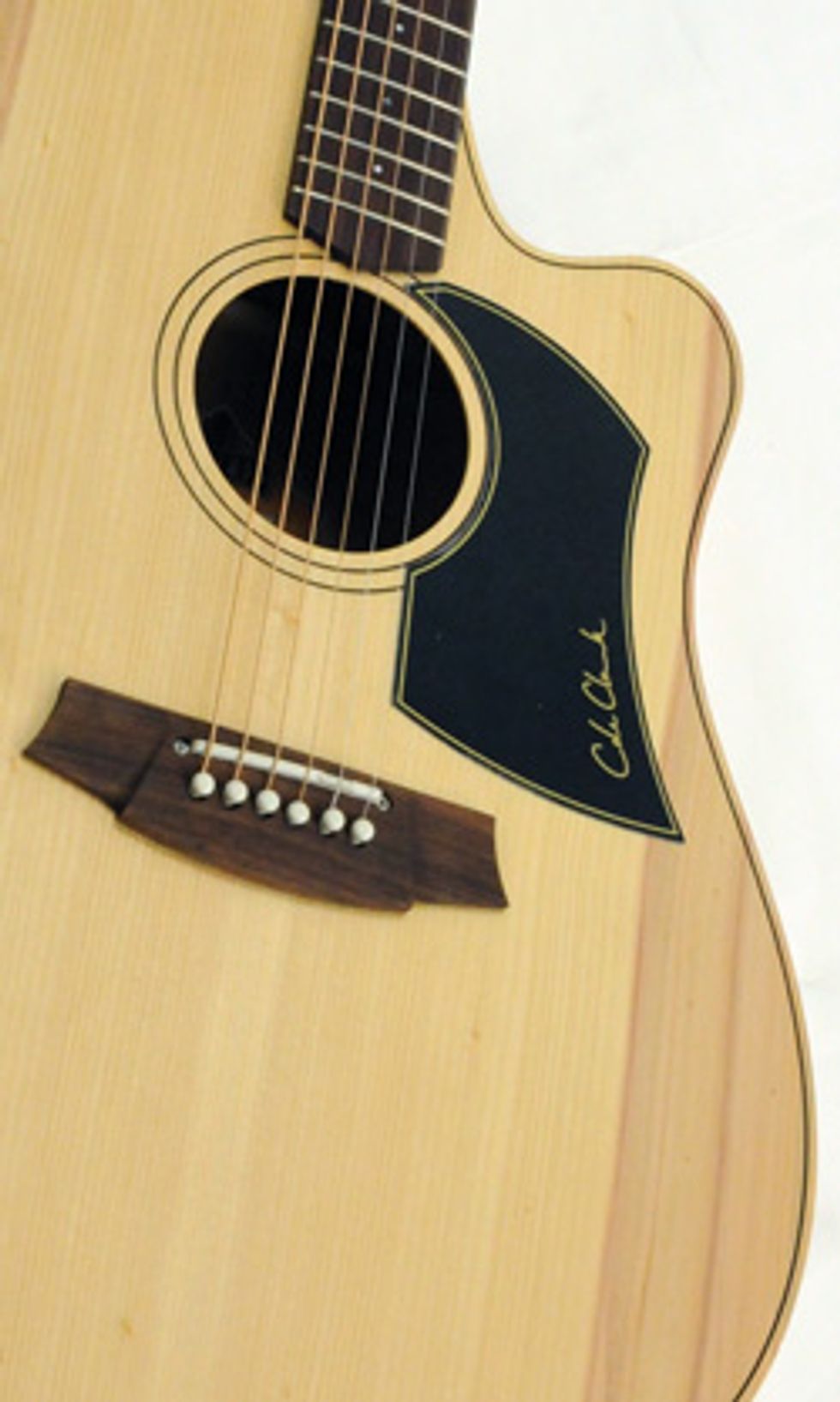How many times recently have you walked in to a guitar shop and seen acoustics made out of wood you’d never seen before? If you’re like me, you gravitate to those guitars out of curiosity. You pick them up, turn them over, pick out colors and patterns. When you turn it over again, do you stick your nose in the soundhole and take a whiff? Okay, maybe that’s only me and my friend Steve. But you get where I’m going, right?
I’m fascinated by the properties that different woods bring to guitars. I’m also concerned about deforestation, endangered woods, and the displacement of entire communities due to mismanagement of the forests where guitar woods are harvested. Fortunately, the time is ripe for a revolution in lutherie, and woods like cocobolo, jacaranda, bubinga, zebrawood and katalox have become part of the acoustic landscape. It’s also been a chance for makers like Rainsong, CA (Composite Acoustics), Flaxwood and Blackbird to push the boundaries of carbon fiber and composites—and it’s given Ovation a chance to say, “Told you so.”
Never ones to wallow in doom and gloom, we decided to do some fact-finding and get the lowdown on just how endangered some of our old favorites are, and just how viable some of these new additions have been. Our focus is flat top acoustics, so we talked to Richard Hoover of Santa Cruz Guitar Company, Nick Colesanti of Martin, Bob Taylor of Taylor Guitars, Bob Long of Long Guitars, Bradley Clark of Cole Clark Guitars, and Chris Herrod of Luthiers Mercantile to get a broad perspective on this topic.
Tops
Here’s some good news: spruce is not endangered, nor is it in danger of being endangered. That’s particularly good news, because the top is responsible for about ninety percent of a guitar’s tone.
A bunya top on a Cole Clark Guitar from Australia.
The Sitka spruce so commonly used on guitar tops comes from a supplier called Sealaska, based out of the Tongass National Forest in southeast Alaska. In 2004, Fender, Gibson, Martin and Taylor were approached by representatives from Greenpeace, who invited them to visit Tongass and meet with the folks at Sealaska about Forest Stewardship Council (FSC) certification and the importance of sustainability. From this meeting the Music Woods Coalition was born. Nick Colesanti is very excited about the work the coalition is currently doing in assisting Sealaska to get FSC certified: “It’s a long, long process because they’re a big organization, and it’s a lot of lumber, and it’s a lot to do. We’re trying to help them and they’re trying to help us, and we really hope they get there because that would really be a huge success story for the coalition.” The five- and six-foot diameter trees that have been the bread and butter for guitar purposes are few and far between. Chris Herrod says it’s the old growth, very large trees that are endangered: “They’re hard to come by. People want those because the grain is very tight and straight and so forth.” Those trees are not just being turned into construction lumber or kitchen cabinets, either. Many old-growth trees are destined to be ground up and turned into pulp. Martin’s response has been to seek out those pulp mills and try to rescue some of the logs that are suitable for tops. They call it diaperwood.
“I’ll tell you what’s very sad,” says Colesanti. “You’re out in the woods and you’re looking at these mammoth trees, and they’re just beautiful and it took them hundreds of years to grow, right? And all you’re thinking is, wow, someone’s gonna turn this into a diaper? Isn’t there something more noble that can happen with this really cool tree?”
Bob Taylor says as spruce trees get smaller, makers will adapt, and players will “just get okay with it. Maybe by the time we wake up and smell the coffee, we’ve already chopped down all the [big] spruce trees. At that point guitar makers would just start looking at four-piece tops instead of two-piece tops. That’s just what guitars will be then.”
Cedar is another popular top wood for acoustic guitars, but Herrod says it’s not for every player: “Cedar may actually be more plentiful than spruce, but it doesn’t work on a lot of different guitars. It has a great sound on some fingerstyle guitars and classical guitars, but it’s not a really good choice for a hard-driving, flat-picking or strumming guitar. It just doesn’t quite work that way.”
Richard Hoover says Santa Cruz has made it a practice to look for supplies of wood that come from “reclaimed sources like fallen trees and even old structures; and there are an awful lot of spruce-like trees with similar degrees of tonal potential and workability.”
One small builder finding alternate supplies of spruce is Bob Long, who often uses old piano soundboards. “These pianos are typically between 80 and 100 years old when they start to need a rebuild.” he says. “Usually, one that’s rebuilt is a really good quality piano because it’s so expensive to rebuild one, so the soundboard has had really good care.” [See sidebar on how Long processes piano soundboards.]
Australian builder Cole Clark is using bunya, a tree native to Australia, for many of their tops. Bunya, according to Bradley Clark, is “18 percent stronger than Spruce, and gives nothing up for sound.” Approximately ninety-five percent of the bunya they use is plantation grown, and the other five percent is recovered from locally felled trees. Clark says, “I love it for acoustic guitar tops and backs, ukuleles and electric bodies. It is light, stable, resonate, machines very well, is relatively quick growing, indigenous to Australia, looks cool, and is plantation grown! By the way, the bunya nut is quite edible. You can shade, fuel, build, play [guitars], eat and tie up carbon,” all from just one tree.
| Bob Long A Tree’s Third Chance Here’s a little perspective: Taylor says they use 150 spruce logs a year, which is probably very comparable to Martin’s use. A typical sawmill will process 150 logs in a single shift on a single day. At the other end of the scale, Santa Cruz makes in a year about the number of guitars Martin or Taylor will make in a couple days, and Bob Long makes in a year the number Santa Cruz will make in a week. There are advantages to being a micro-builder. Long doesn’t have to worry about whether he can get enough of any kind of wood to satisfy a mass market. He gets much of his top wood from local piano technicians who pull it from pianos that need to be rebuilt. The first step in processing is to take the bracing off: “The braces usually come off pretty easily,” says Long. “Then I sand them down to get the grime and the shellac off so they’re clear, and then stow them away and identify which piano each one came from. I do it so that all the wood in each guitar comes from the same piano. They go into the guitar exactly the way they came out of the piano. All the joints were made by the craftsmen at the Steinway Company or Mason & Hamlin.” The idea came to him because his own family piano was no longer tunable and was going to be disposed of: “It needed too much work to afford to keep it, so rather than send it to the landfill, I took it apart and I used virtually every piece of that piano for something. I made coat racks and shelving— our house is full of old piano things, including two guitars.” Long loves it that he can offer his customers a dimension beyond the ordinary story, “something with a family association or just the added bit of romance that exists when the wood is something more than simply visually pleasing. When somebody says, ‘Tell me about your guitar,’ and the story is ‘Well, it’s Indian rosewood and I gave the guy a check,’ it’s not a very romantic story. Over 100 years ago, someone had the foresight to realize a particular spruce tree, when processed into piano soundboards, had a value greater than newsprint or so many two-by-fours. That lumber then had the opportunity for a second life... a higher calling. The tree lived on as pianos, in homes, schools, churches, and theaters for the next 100-plus years. I like to think that I’m extending that life even further... giving the tree a third life. Where would we be without foresight?” longguitars.com |
Necks, Fretboards and Bridges
 Katalox bridge and "diaperwood" top on a Martin Sustainable Wood OM. |
As for fingerboards and bridges, ebony is the gold standard for a great acoustic, with rosewood a close second. But there are some options emerging from the new, more sustainable logging practices. One of those practices is to clear-cut one acre in the middle of a forest and take everything out. This is a minor wound in the forest that heals over time, but causes less disruption to the forest ecosystem than traditional methods. The companies that clear-cut this way need to find commercial uses for every stick of lumber they get in order to make a profit. One recent success story is katalox, which Martin has used for fingerboards and bridges on some of the guitars in their Sustainable Wood series. It’s comparable to ebony for density, and polishes very well. Its dark purple and brown grain also make a subtle but beautiful accent.
A wood that compares nicely to rosewood is jacaranda, which Long likes to use as much as he can. It’s an ornamental tree seen around plantations in Africa and South America. According to Long, “it polishes very lustrous. Beautiful tap tones. Everything about it I think is as good as any rosewood for a bridge or fingerboard.”
Although some high-end electrics have had great success with carbon fiber fingerboards, acoustic guitarists are extremely resistant to a synthetic. Hoover takes it in stride: “This is another place where we have an enlightened clientele who want to be responsible, but they still want the rare woods with the guitars. It’s really hard to sell the synthetic stuff. They just don’t buy it.” As woods like katalox and jacaranda become more familiar, the demand for ebony and rosewood may ease.
Sides and Backs
 Black walnut back and sides on Long Small Jumbo. |
But that’s a very limited resource and impossible to import legally. It was embargoed in 1969, and the major makers at that time were forced to find alternatives. As Hoover explains, “Martin changed to Indian rosewood, and it became the standard for acoustic guitars. Most people didn’t even notice the change, except for aficionados. And that’s been a pretty practical alternative. In fact, it’s become a staple. But many people didn’t even see it as an alternative.”
Lucky for us, there is an embarrassment of riches to be found in wood choices today. To a lot of trained ears, cocobolo offers a lot of the same qualities that Brazilian rosewood does. In fact, Taylor quips, “People are cuckoo for cocobolo!” Cocobolo has a rosewood-type tone because it’s a hard tropical rosewood-type species, but the sound is a little more compressed than a Brazilian rosewood guitar.
Mahogany, Hoover stated, should already be on the Convention on International Trade and Endangered Species (CITES) list, right behind Brazilian rosewood, because it actually comes from the rainforest. Taylor initiated a program about seven years ago in Honduras. “We have three villages participating now. Each one of these villages cut mahogany for us, and they take so little wood out that they can do it indefinitely. Each village only provides us with about four or five trees a year, and that’s all they can provide. But those trees provide 40 percent of their village’s annual income, so that’s like a premier example of what a nice tidy sustainable operation would be. You take a little bit from a lot of places, and the money goes straight to the people.”
| FSC and CITES Forest Stewardship Council (FSC) FSC is an independent, non-governmental, not-for-profit organization established to promote the responsible management of the world’s forests. FSC has offices in more than 46 countries. It provides standard setting, trademark assurance and accreditation services for companies and organizations interested in responsible forestry. Products carrying the FSC label are independently certified to assure consumers that they come from forests that are managed to meet the social, economic and ecological needs of present and future generations. Visit: fsc.org and accreditation-services.com Convention on International Trade in Endangered Species of Wild Fauna and Flora (CITES) CITES is an international agreement between governments. Its aim is to ensure that international trade in specimens of wild animals and plants does not threaten their survival. It accords varying degrees of protection to more than 30,000 species of animals and plants. CITES is an international agreement to which States (countries) adhere voluntarily. Although CITES is legally binding on the Parties, it does not take the place of national laws. Visit: cites.org |
But a lot of the lower-end mahogany guitars made overseas are made with far less attention to supply chain or labor practices. None of the makers interviewed here have any desire to be perceived as elitist, but all are concerned that the plethora of guitars currently flooding the market in the $99 to $300 range most likely contain wood from questionable sources. Hoover sighs, “There are a lot of hard woods around the world that would work great for musical instruments but they come from areas with absolutely no regulations—or let’s say the industry has no social conscience.”
Walnut is a perfect example of a sustainable tone wood. Grown in orchards all across the US, many makers, and increasing numbers of players, are falling in love with it. Most of the walnut that guitar makers use comes from trees that are at the end of their lifecycle. This happens only once every eightyfive to ninety years for most orchards, but the supply is steady. “Walnut has the breathiness of mahogany, but,” Taylor laughs, “it’s got some balls! A little bit of grit underneath so it can handle a little more snap.” It combines nicely with both cedar and spruce, making it a great choice for fingerstyle or flatpicking guitars.
Colesanti says creating a strong market for alternatives is often a simple matter of listening to the tone: “I think we had talked ourselves into thinking only certain kinds of wood sounds good acoustically for the flat top steel-string guitar. But once we got over that hump and started building with those materials, we found the sound was really good, and then the difficulty became actually convincing folks out in the world that it’s okay to have a guitar made out of that material. A lot of that wood grows right in Pennsylvania, so it’s not like you’re going to South America or Africa or Europe or Australia to find these woods. You can buy maple and cherry and birch and even walnut right here.”
The Future Sounds Brilliant but Warm, with Plenty of Sustain
It’s an exciting time to be an acoustic guitar player. There are more options available than ever before, and it’s possible to know with a great deal of confidence where your wood came from and how it was harvested. With ninety percent of your tone coming from the top of the guitar, it’s possible to use the back and side wood sort of like an EQ. If you learn about different tone woods and what properties they bring to a guitar, you can get incredibly close to your ideal tone before your guitar is even made. That makes me feel like, well, a guitar player in a luthier’s workshop.










![Rig Rundown: Russian Circles’ Mike Sullivan [2025]](https://www.premierguitar.com/media-library/youtube.jpg?id=62303631&width=1245&height=700&quality=70&coordinates=0%2C0%2C0%2C0)










